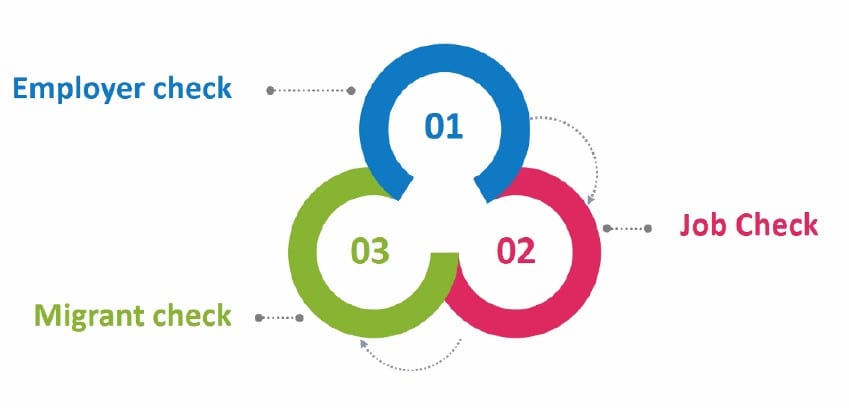Job Check NZ: New Requirements for Hiring Migrant Workers

JOB CHECK NZ: New application process
The new application process for the Accredited Employer Work Visa (AEWV) in New Zealand includes several job checks.
This includes providing a detailed job description outlining the role’s responsibilities, skills, and experience required. Employers should also demonstrate their commitment to fair employment practices by offering an acceptable job offer that complies with employment law and provides a pay period and minimum qualifications that align with industry standards.
The proposed employment agreement should clearly outline the terms and conditions of employment, including the minimum and maximum remuneration. Additionally, employers must advertise the job on a national job listing website to attract potential New Zealand candidates.
By following these guidelines and fulfilling the necessary job checks, employers can successfully hire migrant workers and contribute to the growth and development of their businesses.
Here are the 3 main steps in this process:
- apply for accreditation under the new system
- apply for a job check to make sure the role they want to fill cannot be done by suitable New Zealander workers, and
- request a migrant worker to apply for a visa.
The migrant will need to meet the skills and experience stipulated as part of the New Zealand job check.
New system has 3 checks
The system will introduce 3 checks before a New Zealand employer can hire a migrant worker. These checks are:
- the New Zealand employer check — employers need accreditation to pass this
- the job check
- the worker check.
Job check NZ
For Job Check NZ, INZ will mainly check that:
- the employer holds accreditation and continues to meet the requirement of accreditation.
- the employment is acceptable (the job pays the market rate, at least 30 hours per week, the terms and conditions comply with employment laws)
- there are no suitable New Zealand citizens or residents available to do the work specified.
Labour market test
A labour market test shows you have genuinely advertised the role to New Zealanders and there are no New Zealanders available to do the job. For jobs paying below the New Zealand median wage, the market test includes checking with the NZ Ministry of Social Development.
Jobs that pay 200 % of the median wage do not need the test. Job that pay at, or above, the median wage in NZ regions also do not need it. In cities, jobs that are on a skills shortage list and pay at, or above, the New Zealand median wage don’t need the test.
You can only hire migrant workers if the job check is passed. New Zealand employers pay for a job check.
Details of the advertising requirements and other elements of the test will be announced by INZ soon.
FAQ
1. What is the process for obtaining an Accredited Employer Work Visa in New Zealand, and what is the significance of the job check?
To obtain an Accredited Employer Work Visa (AEWV) in New Zealand, employers must first go through the accreditation process, which involves meeting specific criteria set by Immigration New Zealand. This includes providing a detailed job description that outlines the role’s responsibilities, skills required, and the minimum skills expected. The job must also meet the median wage requirement, and employers should offer an acceptable job offer that complies with employment law. The proposed employment agreement must outline the terms, including minimum and maximum remuneration, and be supported by employment agreement evidence. Once the employer is accredited, they can proceed with the job check, which is crucial for ensuring that no suitable New Zealand workers are available for the role before hiring migrant workers.
2. What are the key factors that determine whether a job check is approved or declined, and what role does the National Job Listing website play in the process?
The approval of a job check hinges on several factors, including whether the employer’s offer meets the market rate and if it pays at least twice the median wage in New Zealand. The detailed job description, job title, and other job details must align with the advertised position. Employers must also demonstrate their commitment to fair employment practices and compliance with employment law. Additionally, the job must be advertised on the National Job Listing website, which is part of the advertising evidence required for the job check. If the job check is approved, the employer can proceed with hiring migrant workers.
3. What is the role of the Labour Market Test in the job check process for the Accredited Employer Work Visa (AEWV), and how does it relate to migrant workers?
The Labour Market Test is a critical component of the job check process for the Accredited Employer Work Visa (AEWV). It serves to ensure that the employer has genuinely advertised the job to New Zealanders and that there are no suitable New Zealand citizens or residents available to fill the position. For jobs paying below the New Zealand median wage, the Labour Market Test includes checking with the NZ Ministry of Social Development to verify that there are no local candidates. However, jobs that pay twice the median wage or those on the green list of specific roles in horticulture or viticulture industries may not require this test. It’s an essential step to assess the job’s market rate and suitability for hiring migrant workers.
4. Can you explain the concept of the NZ Standard Classification and how it impacts the Accredited Employer Work Visa application process?
The NZ Standard Classification plays a vital role in the Accredited Employer Work Visa (AEWV) application process. It helps categorize jobs and occupations in New Zealand based on specific criteria such as skill levels and qualifications. Employers must ensure that their job offerings align with the appropriate NZ Standard Classification for the specific occupation. This classification helps immigration officers assess the job’s suitability and whether it meets the required criteria, including the market rate and minimum qualifications. Ensuring that the job title and description match the correct NZ Standard Classification is crucial for a successful AEWV application.

